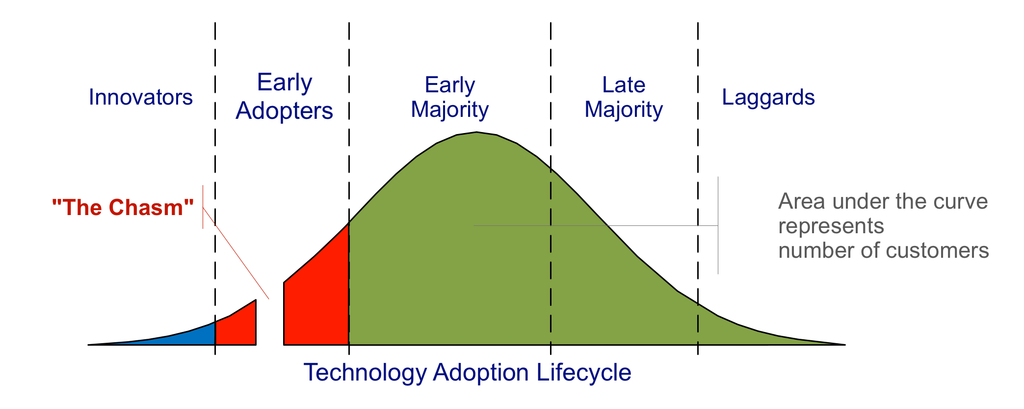The Balancing Act Between Problem Solving and Intentional Innovation
Innovation is one of the reasons why we’ve achieved such incredible progress as a society. Progress, both incremental and exponential, has given us everything from the light bulb and telephone to the printing press and the internet.
In my 28 years in technology and consulting, across all industries and using multiple technology platforms, every project I’ve worked on has started with a problem in need of a solution. Most of us have heard the phrase, “Necessity is the mother of invention,” and that’s certainly true in the realm of new technology platforms and solutions. When we solve problems in the current CRM marketplace, however, we need to take necessity a step further and ask ourselves: are we intentionally innovative in our solution creation?
In his book Crossing the Chasm, Marketing and Selling Disruptive Products to Mainstream Customers, Geoffrey A. Moore describes the various stages of the innovation adoption curve in the marketplace as they relate to the product life cycle. Moore notes that as new products rise in adoption and maturity on the front side, leaders in that industry see huge growth and higher margins as a result. On the front side of the curve, it’s clear new offerings are the heart of innovation. Adoption of new offerings leads to stakeholder’s increased personal investment, and personal investment leads to further proposals from stakeholders for intentional innovation.

On the back-side of the product life cycle adoption curve is commoditization. Optimal commoditization occurs when cost is driven down, and volume providers dominate on slim margins and high efficiency. What often isn’t clear on the back-side of the curve is the role intentional innovation plays in ongoing success. Organizations must reimagine processes and streamline delivery in ways the front-side never imagined through intentional innovation.
Without intentional innovation across the duration of the entire adoption curve, it can be challenging for businesses to survive beyond one product lifecycle. To compete and win through the adoption curve of digital transformation, innovation in your solutions, front-side to back-side, is critical.
Pain Points as a Starting Line for Digital Transformation
Intentional innovation requires more than problem-solving, it requires careful thought into how we can change the overall business situation through process, technology, or education. The goal is to not only embrace and solve the pain point but use the pain point to drive new productivity and creativity along the way.
I once conducted strategic planning with an organization who were victims of their own success. They had grown steadily over 20 years and in doing so added many new lines of businesses along with silos of people, processes, and data. Eventually, they were unable to sell or service across these lines of business effectively. As a result, they were beginning to flounder financially and culturally. Unfortunately, their pain points were so great and their sense of urgency so strong they found it difficult to see beyond the pain and urgency to a holistic vision of what their business could be. They couldn’t see the forest for the trees.
Our team identified ways they could tear down the silos and gain cross-functional traction quickly, but it required a change in the customer’s go-to-market strategy. Ultimately, they decided that our recommendations were too risky, and instead opted for an approach that would retain silos, rather than a more Vision-Led approach. The subsequent pull of time and resources consumed by this ‘fix-it’ solution eventually drained away the business’s ability to execute effectively across all their lines of businesses. Focusing too much on the pain points without taking the time to reflect on the art of the possible put their business into a state of steady decline from which they never recovered.
Pain Points in Digital Transformation are Opportunities to Innovate
Being intentionally innovative requires us to shift our focus away from merely solving the pain and onto the opportunity present for intentional innovation. When we start looking at our customer’s pain as an opportunity to delight them, we open up new possibilities in their minds and in ours. We become intentionally innovative partners primed for long-term success.
The benefits of being intentionally innovative include differentiation from your competition and boosting your business growth, but they also include:
- Becoming more customer-centric
- Becoming thought leaders in the industry and marketplace
- New opportunities to reimagine and reignite processes, tools, and teams
I think we can agree that these benefits are compelling reasons to leverage pain points and through them, embrace continuous intentional innovation.
Silverline’s Intentional Innovation Strategy
At Silverline, being intentionally innovative is a core value of our team and defines how we approach our client relationships. We regard innovation as an ongoing process that begins at the start of our client relationship. We ask critical questions like “What makes your business special?” and “Who is your customer?” We establish the answers to these questions as essential factors of success in our engagement. As we create solutions, we have checkpoints to confirm that we aren’t just building things for the sake of building, we’re actually meeting critical success factors, remaining Adoption-Driven. We focus on the program journey and how it aligns to customer delight, keeping in mind that a product release is just the beginning of a life cycle of intentional innovation in a client’s business.
Being intentionally innovative isn’t a luxury, it’s a necessity for the survival of your business. There will always be pains we have to resolve, but the key differentiator in successful deployments is using that pain to drive intentional innovation, not to create Band-Aid solutions. Properly leveraging this pain as a factor of successful change allows us to maintain the precarious balance between problem-solving and innovating. That balance is the secret to intentional innovation within your digital transformation.
Whether you’re new to digital transformation and driving governance or you need to jumpstart your existing journey map, Silverline has best practices to help you navigate your route. Subscribe to the Silverline blog as we dive into each of the 10 Keys to Successful Digital Transformation on the Salesforce platform, or reach out to me at [email protected] to schedule a demo.




